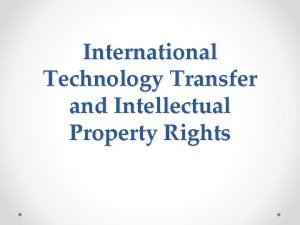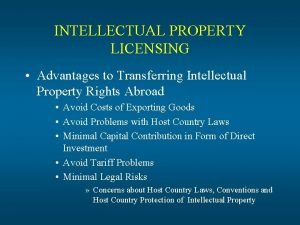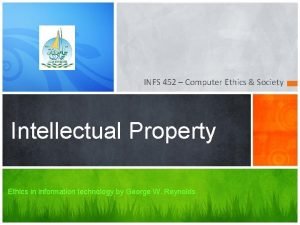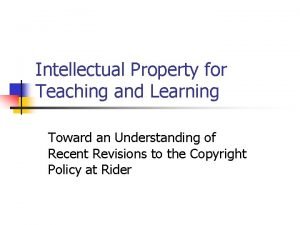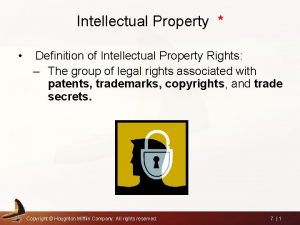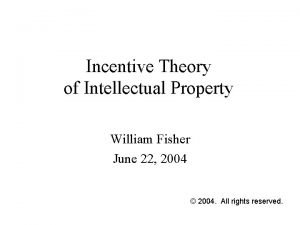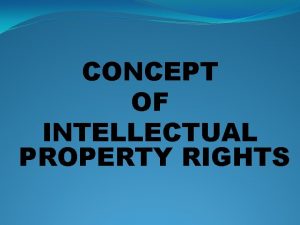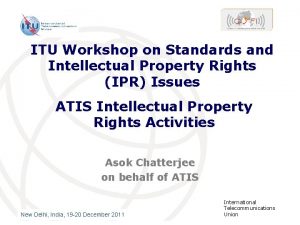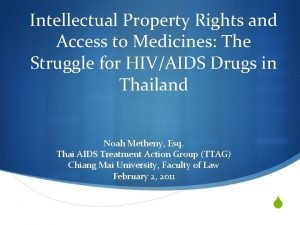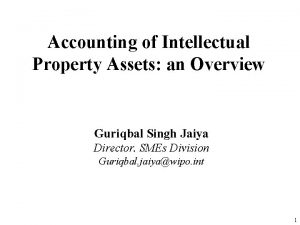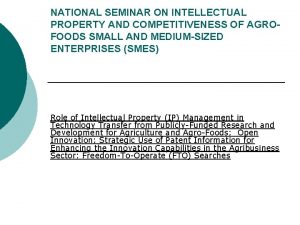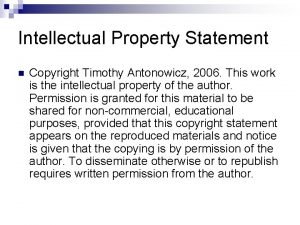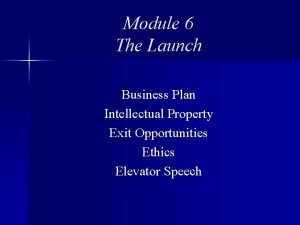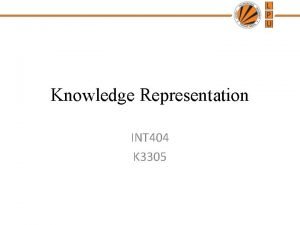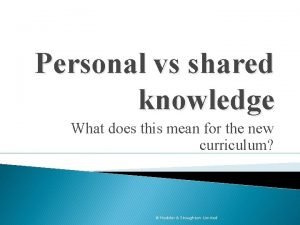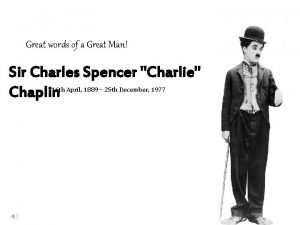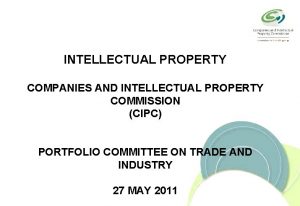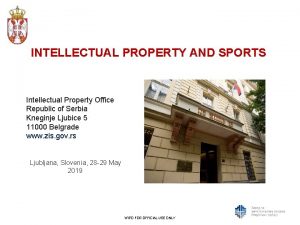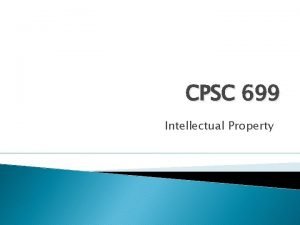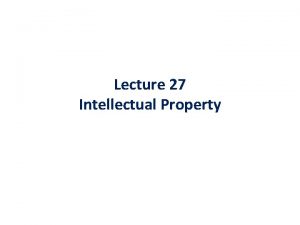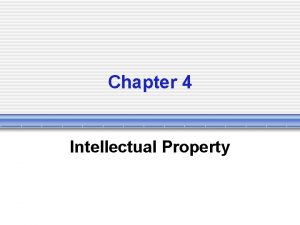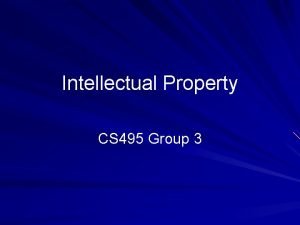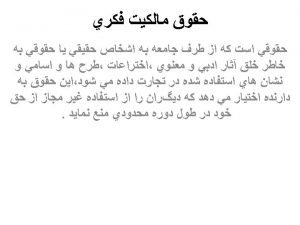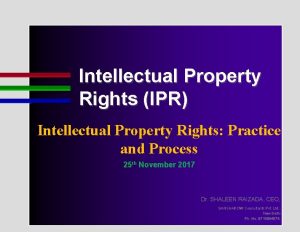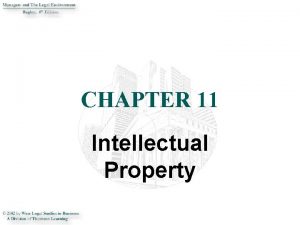Intellectual Property and Traditional Knowledge Wendland Director Traditional















![Prevention of access and use without prior and informed consent [exclusive rights model] Acknowledgement Prevention of access and use without prior and informed consent [exclusive rights model] Acknowledgement](https://slidetodoc.com/presentation_image/92ff8323bcf5d6ff9c5de61cff3952e2/image-16.jpg)




















- Slides: 36

Intellectual Property and Traditional Knowledge Wendland Director Traditional Knowledge Division WIPO, Geneva

Jargon buster. . . WIPO : World Intellectual Property Organization TK: Traditional knowledge GRs: Genetic resources TCEs: Traditional cultural expressions IP: Intellectual property IGC: WIPO Intergovernmental Committee on Intellectual Property and Genetic Resources, Traditional Knowledge and Folklore

Key messages WIPO’s IGC is negotiating an international legal instrument(s) Significant progress in the last two years: but much work remains IGC is engaged in a profound ‘contest of ideas’ States will make critical decisions on the future of the negotiations in October 2012 WIPO’s Member States have explicitly welcomed and encouraged the effective participation of Indigenous Peoples For an intergovernmental process, Indigenous Peoples have remarkable opportunities to participate directly: but there can be improvements

Outline The negotiations at WIPO: background, current mandate and program Intellectual property and traditional knowledge: what are some of the issues? Draft text on the protection of traditional knowledge: main provisions and key options IP and genetic resources: what are the issues? Closing remarks

• Intellectual property and traditional knowledge: what are some of the issues?

Traditional knowledge is valuable and important TK is under threat, however Therefore, Indigenous Peoples, local communities and many States call for the greater protection, safeguarding, preservation and promotion of TK

However, “protection” can have different meanings. . . what does an “intellectual property approach” to protection mean. . . ?

TK would be recognized as a form of “intellectual property” – i. e. , as comprising creations and innovations of the human mind The protection of TK would provided by a special system or mechanisms based on the kinds of measures, principles and values that comprise the system established for the protection of intangibles (the intellectual property system) • this does NOT, however, mean forcing a square peg (TK) into a round hole (the conventional IP system)!

Protection of “intangible property” is different to the protection of “tangible property” (eg. , land) Features of this intellectual property system include: Property rights (e. g. exclusive rights) and nonproperty rights (e. g. moral rights, unfair competition, right to equitable compensation) Balance and proportionality: IP rights do not provide absolute and perfect control: limitations and exceptions/limited term/the role of the ‘public domain’ In some respects, existing intellectual property rights can be used to protect TK and TCEs and, especially, their contemporary adaptations and derivations

• Is an “intellectual property approach” the only suitable approach?

NO! The work of WIPO is only of interest/use to you if you: regard TK as deserving the same kind of protection as is granted to “non-traditional” innovations and creations, and want a say over if and how your traditional creativity and innovations are accessed and used by third parties (like other intangible properties)

TK: what are the specific IP issues?

Innovations based on TK are generally patentable But, save for secret TK, the ‘underlying’ TK is generally ‘public domain’ (unprotected) So, the basic question is: should underlying TK – which generally ‘belongs’ to Indigenous and local communities be ‘protected’ in the IP sense?

What do we mean by “protection” of TK/TCEs? Positive protection (an intellectual right in TK/TCEs, to authorize or prevent use) Defensive protection (avoidance of IP rights in TK/TCEs – e. g. , Indian TKDL; USA’s Native American Insignia Database)

What models might be appropriate?
![Prevention of access and use without prior and informed consent exclusive rights model Acknowledgement Prevention of access and use without prior and informed consent [exclusive rights model] Acknowledgement](https://slidetodoc.com/presentation_image/92ff8323bcf5d6ff9c5de61cff3952e2/image-16.jpg)
Prevention of access and use without prior and informed consent [exclusive rights model] Acknowledgement of source + prevention against derogatory use [moral rights model], and/or Benefit-sharing/compensation [access and benefitsharing/compensatory liability/ “use now, pay later” models]

What are some of the other key issues?

Definitional issues What is “traditional” knowledge? Should all TK receive protection? Who should be the beneficiaries of new rights in TK? Technical issues How would special protection for TK interact with protection available under existing IP? How should publicly available TK and transboundary (“shared”) TK be addressed? What scope of rights strikes the right balance? Which exceptions and limitations might be appropriate? How long should protection last? Operational issues What role, if any, should registration/documentation play in the protection of TK? Procedural issues What belongs in an “international instrument” and what should be left to national legislation?

WIPO’s activities on traditional knowledge: what does WIPO do?

Norm-setting: the WIPO Intergovernmental Committee on Intellectual Property and Genetic Resources, Traditional Knowledge and Folklore (the IGC) Technical assistance and capacity-building: for States, communities, research institutions and museums, archives

The negotiations at WIPO: background, current mandate and program

WIPO Intergovernmental Committee Established in 2000; met for the first time in April 2001 IGC was preceded by several years of fact-finding, consultation, research; including two roundtables on intellectual property and indigenous peoples (1998 and 1999) and fact-finding missions to 30 countries (1998 and 1999) IGC participants: Member States, indigenous and local communities, business, civil society and other NGOs

Genetic resources (GRs) Traditional knowledge (TK) Traditional cultural expressions (expressions of folklore) (TCEs)

The IGC is conducting text-based negotiations with objective of reaching agreement on an international legal instrument(s) The WIPO General Assembly in October 2012 will take stock of progress and decide on convening a Diplomatic Conference

Challenges. . . Diverse stakeholders, diverse objectives International coherence: fragmentation of international norm-setting Top-down or bottom up: minimal successful national experience Participation: challenges to inclusivity Legislative approach: interface with practical mechanisms

Opportunities. . . Historical opportunity: first developing country -led international normative process in IP Cutting edge: fresh uses for age-old IP values and principles Narrowing the trust-gap: growing confidence in the process and multilateralism International comity: IP and mutual supportiveness

• Draft text on the protection of traditional knowledge: main provisions and key options

The Protection of TK: Draft Articles Policy Objectives General Guiding Principles Article 1 – Subject Matter of Protection Article 2 – Beneficiaries of Protection Article 3 – Scope of Protection Article 4 – Sanctions, Remedies and Exercise of Rights Article 5 – Administration of Rights Article 6 – Exceptions and Limitations Article 7 – Term of Protection Article 8 – Formalities Article 9 – Transitional Measures Article 10 – Consistency with the General Legal Framework Article 11 – National Treatment and other Means of Recognizing Foreign Rights and Interests Article 12 – Trans-Boundary Cooperation


• IP and genetic resources: what are some of the issues?

IP and genetic resources: what are the issues? Genetic resources are not “intellectual property” – access and benefit-sharing in GRs are dealt with in other conventions and treaties (CBD (+ Nagoya), FAO)

Inventions based on or derived from GRs may be patentable. This raises questions concerning the relationship between patent law and the CBD: ‘defensive protection’ of GRs: prevention of erroneous patents: databases proposal “quality of patent examination” issue tracking compliance with the CBD: mandatory disclosure proposal “support of IP system for CBD” issue

• Closing remarks

IGC has made significant progress in the last two years: but much work remains Negotiations are a vibrant contest of ideas IGC’s negotiations represent an historic opportunity for IP policymakers IP experts are encouraged to participate

Information Tools and Resources

Sign up for the TK e-Newsletter and Updates grtkf@wipo. int wendland@wipo. int END
 Trade related aspects of intellectual property rights
Trade related aspects of intellectual property rights Secondary infringement
Secondary infringement Importance of intellectual property
Importance of intellectual property Intellectual property management definition
Intellectual property management definition Advantages of intellectual property
Advantages of intellectual property Example of intellectual property in business plan
Example of intellectual property in business plan Property
Property Right to intellectual property of teachers
Right to intellectual property of teachers Industrial property definition
Industrial property definition Incentive theory
Incentive theory Concept of intellectual property
Concept of intellectual property Intellectual property valuing
Intellectual property valuing Intellectual property rights
Intellectual property rights Intellectual property rights
Intellectual property rights Characteristics of intellectual property
Characteristics of intellectual property Discuss intellectual property frankly
Discuss intellectual property frankly Sfas 142
Sfas 142 Intellectual property
Intellectual property Intellectual property statement
Intellectual property statement Intellectual property business plan example
Intellectual property business plan example Evalueserve patent search
Evalueserve patent search Discuss intellectual property frankly
Discuss intellectual property frankly At&t ecommerce
At&t ecommerce Coparcenary property and separate property
Coparcenary property and separate property Chemical property definition
Chemical property definition Knowledge creation and knowledge architecture
Knowledge creation and knowledge architecture Commutative property vs associative property
Commutative property vs associative property Which is not a property of representation of knowledge?
Which is not a property of representation of knowledge? What is shared knowledge
What is shared knowledge Knowledge shared is knowledge squared
Knowledge shared is knowledge squared Knowledge shared is knowledge multiplied meaning
Knowledge shared is knowledge multiplied meaning Contoh shallow knowledge dan deep knowledge
Contoh shallow knowledge dan deep knowledge A priori
A priori Book smarts vs street smarts
Book smarts vs street smarts Knowledge and knower
Knowledge and knower Gertler econ
Gertler econ English comic actor and film director
English comic actor and film director


